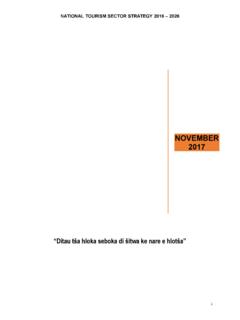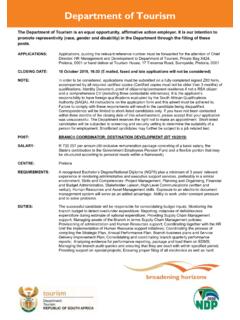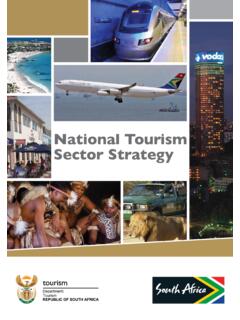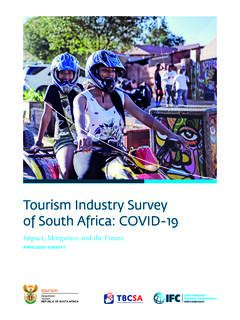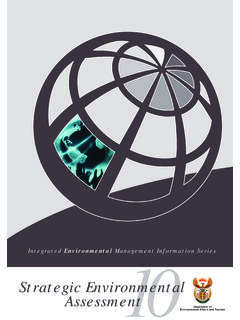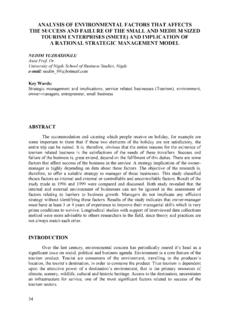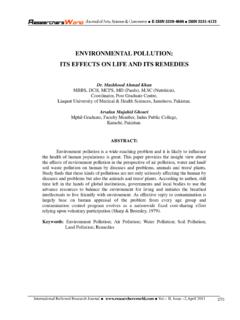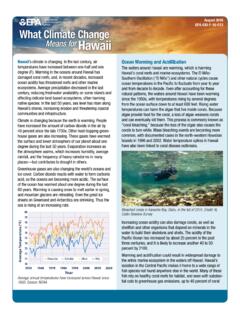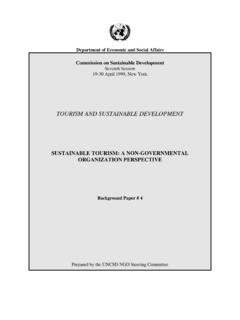Transcription of THE DEVELOPMENT AND PROMOTION OF TOURISM IN …
1 WHITE PAPER. THE DEVELOPMENT AND PROMOTION . OF TOURISM IN SOUTH AFRICA. GOVERNMENT OF SOUTH AFRICA. DEPARTMENT OF environmental AFFAIRS AND. TOURISM . MAY, 1996. Table of contents Abbreviations Definition of Terms The Policy Formulation Process PART I: THE ROLE OF TOURISM IN SOUTH AFRICA. South Africa's TOURISM Potential Role in the Economy Recent Performance PART II: THE PROBLEMATIQUE. A Missed Opportunity Key Constraints PART III: TOWARDS A NEW TOURISM . TOURISM and the RDP. Why TOURISM ? Any Kind of TOURISM ? Responsible TOURISM Effects of Irresponsible TOURISM PART IV VISION, OBJECTIVES AND PRINCIPLES. Vision Guiding Principles Critical Success Factors Key Objectives Specific Targets PART V: IGNITING THE ENGINE OF TOURISM GROWTH. Safety and Security Education and Training Financing TOURISM Investment Incentives Foreign Investment environmental Conservation Cultural Resource Management Product DEVELOPMENT Transportation Infrastructure Marketing and PROMOTION Product Quality and Standards Regional Cooperation Youth DEVELOPMENT PART VI: ROLES OF THE KEY PLAYERS.
2 Role of the National Government Role of the Provincial Government Role of Local Government Role of the Private Sector Role of Labour Role of Communities Role of Women Role of NGOs Role of the Media Role of Conservation Agencies PART VII ORGANISATIONAL STRUCTURE. Ministry of environmental Affairs and TOURISM Department of environmental Affairs and TOURISM National TOURISM Organisation Responsibilities of National TOURISM Organisation Representation and Reporting Relationships Committees of the Board Establishment of the National TOURISM Organisation Provincial TOURISM Organisations The Way Forward Abbreviations CBO Community-based Organisation DTI Department of Trade and Industry EU European Union FIT Foreign Independent Tourists GDP Gross Domestic Product GEM Group for environmental Monitoring IPTC Inter Provincial Technical Committee ITTT Interim TOURISM Task Team Committee of Members of Executive Councils responsible for TOURISM in the MINMEC provinces and the Minister and Deputy-Minister of environmental Affairs and TOURISM in the central government NGO Non-governmental Organisation RDP Reconstruction and
3 DEVELOPMENT Programme RETOSA Regional TOURISM Organisation of Southern Africa SADC Southern African DEVELOPMENT Community SATOUR South African TOURISM Board SMMEs Small, Micro and Medium-sized Enterprises USP Unique Selling Point VFR Visitors to Friends and Relatives Definition of Terms cultural aspects which are of interest to the visitor and can be Cultural TOURISM marketed as such, including the customs and traditions of people, their heritage, history and way of life. environmentally and socially responsible travel to natural or near natural areas that promotes conservation, has low visitor impact and Ecotourism provides for beneficially active socio-economic involvement of local people population groups entering the market in increasing numbers as Emerging markets domestic tourists, especially those previously neglected. small, micro and medium-sized enterprises owned and/or operated Emergent SMMEs by the previously neglected population groups that are entering the market Environment includes natural, urban, human living and cultural environments a person who travels to a country other than that in which she/he has her/his usual residence, but outside her/his usual environment, for at least one night but less than one year, and the main purpose of whose visit is other than the exercise of an activity remunerated from within International tourist the country visited.
4 Due to markedly different travel and expenditure patterns, a distinction is drawn between international tourists from the rest of Africa (called regional tourists) and those from other countries (called overseas tourists). See definition of tourist. Previously neglected population groups that were largely excluded from mainstream communities TOURISM activities. TOURISM that promotes responsibility to the environment through its sustainable use; responsibility to involve local communities in the Responsible TOURISM TOURISM industry; responsibility for the safety and security of visitors and responsible government, employees, employers, unions and local communities Statutory an organisation established by an Act of Government Organisation/parastatal a person who travels away from home for other than commuting Stop-over visitor purposes, staying less than 24 hours in the place visited DEVELOPMENT TOURISM DEVELOPMENT , management and any other TOURISM activity which optimise the economic and other societal Sustainable TOURISM benefits available in the present without jeopardising the potential for similar benefits in the future all recipients of direct spend incurred by tourists.
5 This includes pre- The TOURISM industry trip expenditure on travel and booking, travel and en-route expenditure, and all spending at the destination a person who travels away from home, staying away for at least one night. A tourist can be a domestic tourist (for example resident of Johannesburg staying one night in Durban), a regional tourist ( a Tourist visitor from Zimbabwe spending one or more nights in the Free State) or an overseas tourist (a resident of Germany staying one or more nights in the North-West Province). See definition of international tourist. A tourist travels for different purposes including business, leisure, conference and incentive. all travel for whatever purpose, that results in one or more nights TOURISM being spent away from home Traditional domestic previously advantaged domestic leisure tourists markets The policy formulation process In October 1994, the Minister of environmental Affairs and TOURISM appointed the Interim TOURISM Task Team (ITTT) with the mandate of drafting a TOURISM discussion paper as a basis for a future national TOURISM policy.
6 Representing the business sector, labour movement, provincial governments, community organisations and the national government, the ITTT. produced a TOURISM Green Paper in September 1995. The TOURISM Green Paper was widely distributed for comment, whereafter the European Union was approached to provide technical assistance to the Government of South Africa in developing a TOURISM White Paper. An international TOURISM specialists was appointed by the European Union for this purpose, in October 1995. It was recognised that the process of arriving at a White Paper for TOURISM is as important as the White Paper itself. As such, a great deal of emphasis was placed on developing the White Paper in such a way as to facilitate maximum participation by all. To this end, the process involved a number of research methods and strategies as follows: 1. A number of ITTT meetings were held to monitor progress and provide comments on the process followed and the content of the document.
7 2. Ten workshops were held country-wide to discuss the Green Paper and obtain inputs for the White Paper. More than 500 persons participated in these country-wide workshops. 3. Nearly 100 expert interviews and one-on-one consultations were carried out with key stakeholders in the industry. 4. More than 100 written submissions were received and reviewed. 5. A number of strategic meetings were attended, including meetings of MINMEC, IPTC, Hotel Industry Liaison Group, the Strategic TOURISM Security Workshop, Museum Workshop and the national TOURISM workshop held on 4 March 1996. 6. Local consultants were appointed by the lead consultant to assist in carrying out secondary research and analysis of the TOURISM industry as well as the DEVELOPMENT of strategies and implementation programmes. 7. The consultants drew upon a number of reports by SATOUR and other organisations, White Papers of other government departments and other relevant documents.
8 The White Paper provides a policy framework and guidelines for TOURISM DEVELOPMENT in South Africa. It will be followed by an implementation strategy which will contain a number of key actions in order to effectively implement the guidelines contained in the White Paper PART I: ROLE OF TOURISM IN SOUTH AFRICA. TOURISM potential With a population of approximately 41 million and a land area of million sq. km (nearly five times the size of the UK), South Africa's resource base for TOURISM is phenomenal. The country's TOURISM attractiveness lies in its diversity. Some of the features which make South Africa an incredibly attractive TOURISM proposition include: accessible wildlife, varied and impressive scenery, unspoiled wilderness areas, diverse cultures (in particular traditional and township African cultures), generally sunny and hot climate, no 'jet lag' from Europe, a well- developed infrastructure and virtually unlimited opportunities for special interest activities such as whale-watching, wild water rafting, hiking, bird-watching, bush survival, deep-sea fishing, hunting and diving.
9 In addition, unique archaeological sites and battlefields, the availability of excellent conference and exhibition facilities, a wide range of sporting facilities, good communication and medical services, internationally known attractions (Table Mountain, Cape of Good Hope, Sun City, Kruger National Park, Garden Route, Maputaland) and unrivaled opportunities to visit other regional internationally known attractions ( Victoria Falls and the Okavango Swamps) make South Africa an almost complete tourist destination. TOURISM has become a fiercely competitive business. For TOURISM destinations the world over, as indeed for South Africa, competitive advantage is no longer natural, but increasingly man-made - driven by science, technology, information and innovation. As such, it is not simply the stock of natural resources of South Africa that will determine her competitiveness in TOURISM , but rather, how these resources are managed and to what extent they are complemented with man- made innovations.
10 In this regard, South Africa scores well on three important fronts. First, the already well-established network of national parks (covering some of the surface area of the country) and private nature reserves are very much 'on trend' with the demands of the increasingly environmentally sensitive visitor. Second, some companies are already leaders in global 'best practice' in ecotourism, while others have created Disneyland-like attractions in South Africa, boosting the country's name internationally. Third, the recent successful political transformation in South Africa has virtually 'opened' the country's TOURISM potential to the rest of the world and indeed to the previously neglected groups in society. It is not surprising that the World TOURISM Organisation in its 1995 review of African TOURISM considers South Africa to be "one of the most promising TOURISM destinations of the African continent".

